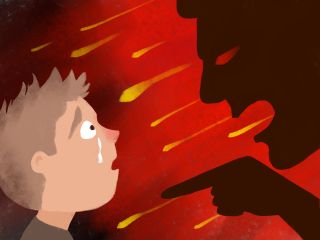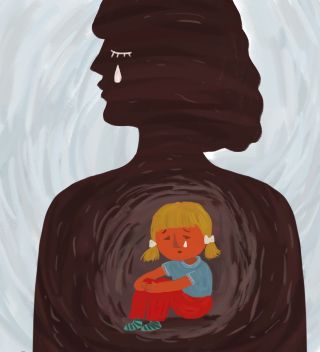Self-Talk
Decoding the Inner Critic's Origins and Purpose
The critic scans threats and strives to shield the potency of emotional pain.
Posted December 16, 2023 Reviewed by Lybi Ma
Key points
- A harsh inner critic develops when a child never or rarely feels considered good enough by others.
- Deprived of love, facing indifference and neglect from others, the child internalizes a sense of being flawed.
- Serving a protective role to cope with difficulties in childhood, the inner critic persists into adulthood.
The inner critic manifests as an internal voice characterized by self-judgment and a critical stance toward oneself. This voice shapes self-perception and contributes to feelings of inadequacy, anxiety, or depression.
Even though the inner critic is focused on current life, it is shaped by events and relationships from childhood. In a child's upbringing, the inner critical voice likely played a constructive role, where the ability to read changes in the surroundings and the capacity to shift in and out of different aspects of oneself have been essential in dealing with a challenging environment.
Roots in Childhood
Research suggests that people with harsh self-critical tendencies, encountered frequent judgments, ridicule, and a scarcity of positive regard during their childhoods. These experiences extend to relationships with parents, teachers, siblings, and peers. Additionally, societal expectations amplify and mold these self-critical tendencies, forming a complex interplay of influences. However, most emphasis is placed on parental influence. Children raised in families with critical, controlling, demanding, abusive, or indifferent parents, often tend to develop a harsh inner critic. Essentially, the inner critic acts as an introjected, critical parental figure.

In a child's early life, parents constitute the entire world and the little child perceives no possibility that fault lies with the adults. Thus, when a child naturally approaches surroundings with curiosity, expecting a safe return, but instead repeatedly encountering indifference, denial, contempt, or subtly undermining narratives about who the child is, the child inevitably perceives it safer to blame themselves for all the confusion and pain it feels rather than the parent for their behaviors. The child internalizes the attitudes of the parent(s) and adopts the critical stance displayed by adults as their inner dialogue. In doing so, the child gains an illusion of safety and control, reducing their overwhelming anxiety to some degree.
Consequently, their natural and healthy process of valuing oneself transforms into a rigid and inflexible set of standards, expectations, or obligations of the self that become fixed, and static, disconnecting the child from its natural essence. Gradually it turns into an automatic coping mechanism for dealing with life's challenges. The unintended outcome is that the individual continues this behavior even when it becomes unnecessary. These early-developed critical and negative evaluations carry a false self-image into adulthood where the inner critic often feels more like the authentic adult self.
While some people internalize shame, assuming responsibility for perceived shortcomings, others tend to adopt a contrasting approach, manifesting in bullying tendencies. The latter group mirrors the behavior of those who have subjected them to mistreatment, often deflecting blame onto others when faced with adversity.
The Inner Critic's Purpose
In a dysfunctional upbringing, internalizing a critic can be helpful for a child. However, it is not likely for the inner critic to disappear on its own when the person has grown up and the critic is no longer needed. The inner critic fails to realize that the person has grown into an adult, abundant in strengths and resources. Instead, it continues to demean, comparing in malicious ways and providing reasons for the person to feel undeserving of their place in the world.

The human psyche is organized around avoiding pain. Therefore, the inner critic works hard to manage the person's life so that they don’t face potential emotional pain. The inner critic believes that a person's survival depends on the critic. Therefore, it continuously monitors threats and measures safety. When something in the present resembles the pain from early life, it reactivates the potency of painful emotions and the critic goes in high gear to protect the person. For example, the inner critic surfaces when we are ignored, rejected, or judged. It then criticizes and controls, urging improvement and productivity to avoid judgment and ridicule similar to what the person faced during their childhood. The inner critic can arise during life's challenges, such as job loss. Surprisingly, it may also manifest when achieving success, for example, when landing a dream job. In the face of job loss, the inner critic uses self-blame to motivate self-improvement. Conversely, when securing a dream job, it begins to manage expectations by whispering messages of caution to prevent disappointment. Upon closer examination, it becomes evident that the inner critic is trying to act in your best interest.
However, despite the inner critic's good intentions to shield from harm, it does not act wisely. Paradoxically, while it intends to keep us safe, it also increases the sense of internal threat, leading to the person feeling worse, keeping them from attaining their potential and living a full life. It adopts “black-and-white,”, “always-never,” and “everything-nothing" positions. It repeatedly personalizes, exaggerates perceived threats, and catastrophizes to evoke negative emotions about past events or instill fear regarding future outcomes. The relentless nature of the inner critic, employing shaming, blaming, and criticizing indiscriminately, creates a false sense of security, contributing to a pervasive sense of isolation.
Operating on an Autopilot
People may not consciously notice that they are “beating themselves up,” their critical voice feels so normal that they don't even notice it. The negative thoughts are generated without conscious effort, occurring out of awareness. However, a hidden and unaddressed inner critic has a significant influence over a person due to its unconscious nature. When unaware of its existence and approaches, there's no opportunity to address it. It is just like having someone speaking negatively behind your back, leaving you in the dark about the origin of rumors, making it impossible to confront them.
Driven by an unconscious inner critic, people conform to their early internalized standards and accept judgments, rather than critically evaluating and choosing what aligns with their satisfaction and needs. This leads to a person's vital needs going unnoticed, minimized, or lost, disrupting authenticity and harmony with their life force. Therefore, delving into and addressing the inner critic becomes essential to disrupting its limiting influence and acquiring skills for new, fulfilling actions.
References
Earley, J. (2009). Self-therapy: A step-by-step guide to creating wholeness and healing your inner child using IFS. Larkspur, CA: Pattern System Books.
Elliott, R., Watson, J., Goldman, R., & Greenberg, L. (2004). Learning emotion‐focused therapy: The process‐experiential approach to change. Washington, DC US: American Psychological Association.
Fisher, J. (2017). Healing the fragmented selves of trauma survivors: Overcoming internal self-alienation. Routledge/Taylor & Francis Group.
Gilbert P., Clarke M., Hempel S., Miles J. N., Irons C. (2004). Criticizing and reassuring oneself: An exploration of forms, styles and reasons in female students. Br J Clin Psychol. Mar;43(Pt 1):31-50. doi: 10.1348/014466504772812959
Gilbert, P. & Procter, S. (2006), Compassionate mind training for people with high shame and self-criticism: overview and pilot study of a group therapy approach. Clin. Psychol. Psychother., 13: 353-379. https://doi-org.proxy.findit.cvt.dk/10.1002/cpp.507
Gilbert, P., & Irons, C. (2005). Focused therapies and compassionate mind training for shame and self-attacking. In P. Gilbert (Ed.), Compassion: Conceptualisations, research and use in psychotherapy (pp. 263–325). Routledge. https://doi.org/10.4324/9780203003459
Rogers, C. R. (1951). Client-centered therapy; its current practice, implications, and theory. Houghton Mifflin.
Stiegler J.R., Vildalen V.U, Heggem T., Ismaili S.B., Schanche E. (2022), The effect of the two-chair dialogue intervention on self-compassion - adding an emotional evocative component to a basic Rogerian condition, Counselling and Psychotherapy Research published by John Wiley & Sons Ltd on behalf of British Association for Counselling and Psychotherapy, https://doi.org/10.1002/capr.12534
Stinckens N., Lietaer G., & Leijssen M. (2013) Working with the inner critic: Process features and pathways to change, Person-Centered & Experiential Psychotherapies, 12:1, 59-78, https://doi.org/10.1080/14779757.2013.767747
Søderberg (2020), Til dig med borderline - og til dem der holder af dig, https://michaelsoederberg.dk/borderline/
Whelton, W. J., & Greenberg, L. S. (2005). Emotion in self-criticism. Personality and Individual Differences, 38(7), 1583–1595. https://doi.org/10.1016/j.paid.2004.09.024




